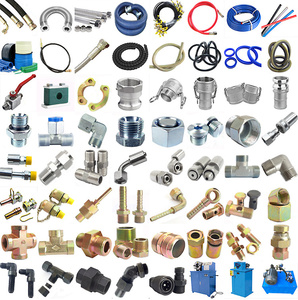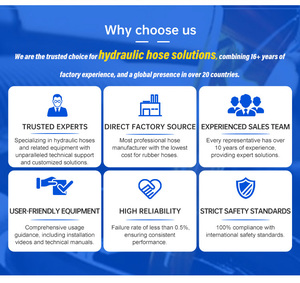
All categories
Featured selections
Trade Assurance
Buyer Central
Help Center
Get the app
Become a supplier

(80 products available)








































Hydraulic hoses are crucial components in fluid power transmission systems. Commonly applied in machinery and vehicle systems. Several types of hydraulic hoses exist. Each is tailored for particular operational requirements, pressure ratings, and environmental circumstances.
This diversity in hose design helps ensure that the appropriate hose can be picked depending on the operational requirements of a particular application.
Wire Braided Hydraulic Hoses
Wire-braided hydraulic hoses are among the most common hoses employed in sectors such as agriculture. automotive, and construction. High-pressure fluid transmission demands this type of hose.
This hose style is often made from rubber or synthetic rubber reinforced with steel wire braids in the hose's structure. It can therefore withstand the rigors of high-pressure jobs. It can also withstand temperature fluctuations that may occur during these operations. Furthermore, enhanced flexibility allows easy integration into complex machinery designs.
Spiral Wire Hydraulic Hoses
Usually, Spiral wire hydraulic hoses are employed when a hose needs to handle extremely high pressures, often exceeding 3,000 PSI. Unlike braided hoses, spiral hoses use steel wire arranged in a helical pattern around the hose. Therefore, this arrangement offers better resistance to crushing and kinking, which makes it ideal for heavy machinery working under extreme conditions.
Textile Reinforced Hydraulic Hoses
Usually, textile reinforced hydraulic hoses are commonly used in low to medium-pressure applications. Such hoses are lightweight and flexible compared to their wire-braided counterparts. This makes them easier to handle in remote locations. Additionally, these hoses are often more affordable.
This helps keep costs down on projects that do not need the higher durability and strength of more expensive hose types. Nevertheless, textile-reinforced hoses typically have lower temperature and chemical resistance. Hence, limiting their usage to settings with less severe mechanical conditions.
Special Application Hydraulic Hoses
Specific purpose hydraulic hoses include fire-resistant, abrasion-resistant, or corrugated design hoses to fulfill certain needs. Fire-resistant hoses utilize specially developed materials to protect against inflammatory fluids and extreme heat. These hoses are common in sectors like oil and gas.
Meanwhile, Abrasion-resistant hoses comprise advanced rubber compounds, which protect against the damaging effects of continuous mechanical wear found in mining or construction. Corrugated design hydraulic hoses are extremely flexible. They are employed in confined spaces and have a small bending radius, which is suitable for power-generating equipment.
Often, a hydraulic hose's toughness and quality are essential factors determining its performance and lifespan. These properties are particularly vital for high-pressure, heavy-duty, and continuous-use applications.
Consequently, quality varies significantly from hose to hose, and poor-quality hoses can lead to failures that are both costly and dangerous. Below are some aspects that highlight how durability and quality affect hydraulic hoses.
Material Composition
Rubber, steel, and synthetic materials are normally used to manufacture hydraulic hoses. These inclusions form a significant part of the hose structure. It is noteworthy that premium-quality hoses incorporate high-grade materials with enhanced resistance to temperature variations, aging, and chemical exposure.
Such a measure ensures wet environments and high-heat zones like steel mills and foundries have added durability. A hose that can withstand such an environment reduces the frequency of replacements and, therefore, increased reliability for the end user.
Reinforcement
Usually, the reinforcement of a hydraulic hose is critical to its pressure-bearing capability. Most high-quality hoses feature multiple layers of steel wire braids or spiral wire. These added layers provide extreme pressure resistance while maintaining flexibility. Thus, ensuring that the hose can endure intense operational conditions without deformation or rupture.
Testing and Certification
Often, reputable manufacturers employ strict testing procedures to ensure hose integrity. Common tests include checking for burst pressure, leak-proofness, and fatigue endurance. Furthermore, certification from recognized organizations like ISO or SAE generally indicates compliance of hoses with industry standards. This can give users increased confidence in their performance and safety.
Wear and Tear
Hydraulic hoses are widely used in rugged work environments such as mining, construction, and agricultural fields. Here, they are prone to abrasion, punctures, and general wear and tear. Nonetheless, high-quality hoses often come with outer protective layers composed of specially developed rubber compounds. These protect against mechanical damage while increasing longevity compared to standard hoses.
Installation and Maintenance
Mostly, hose quality affects ease of installation and maintenance. High-quality hydraulic hoses normally feature standardized, durable fittings that allow for seamless installation without special tools. Additionally, these hoses have lower leaks, which reduces the need for constant maintenance checks. Thus, saving valuable time and resources.
Hydraulic hoses are integral components for most businesses across diverse industries. Commonly, they serve as critical links in hydraulic systems enabling the effective transfer of pressurized fluids. Below are some of the commercial applications of hydraulic hoses.
Manufacturing Industry
Usually, hydraulic hoses power machinery's heavy equipment and robots in this sector. For example, they are responsible for operating injection molding machines in the plastic industry. It is worth mentioning that reliable hydraulic hoses enhance production speeds and enable precision control.
This means that any business in the manufacturing industry needs quality hoses to ensure seamless operation and to minimize unexpected downtimes.
Construction
Typically, construction firms use hydraulic hoses to operate their excavators, bulldozers, and backhoes. These hoses help power the digging, lifting, and material handling done by these machines. So, in the construction industry, durable hoses are needed since they face extreme conditions and high pressures.
Agriculture
Traditionally, large farming equipment such as tractors, combines, and hydraulic-powered plows depend on hydraulic hoses, too. Normally, these hoses operate key farming processes like plowing, seeding, and harvesting. This means that durable hydraulic hose Dubai is especially critical to ensuring continuous operations during key planting and harvesting seasons in farming.
Transportation
Commonly, the truck and automotive industries use hydraulic hoses in braking systems, power steering, and liftgates. Usually, quality hoses guarantee safety and reliable vehicle operations. There can also be an improvement in customer satisfaction through proper maintenance of stable hydraulic hose supplies in fleet management businesses.
Mining Industry
Frequent high-pressure hydraulic hoses power pumps, valves, and cylinder equipment in the mining industry. Usually, these hoses are crucial for mineral extraction, drilling, and transporting materials. The durability of these hydraulic hoses is non-negotiable since they need to withstand harsh environmental conditions. Some of these include the extreme pressure commonly associated with mining operations.
There are various types of hydraulic hoses. Each is suitable for distinct applications depending on operational requirements, fluid compatibility, and environmental factors. Therefore, making the right choice is paramount when selecting a hydraulic hose.
Fortunately, understanding the specifics of the hose and the operating environment can help significantly. Here are some aspects to consider when choosing a hydraulic hose.
Pressure and Temperature Ratings
Often, the hose must have pressure ratings that exceed those of the hydraulic system it services. Go for a hose with a higher rating to avoid catastrophic failures, such as burst or leakage, if the hose is put under more pressure than it can handle. Moreover, ensure the hose can withstand the temperature ranges typical in the target environment. For example, industries like oil and gas commonly expose their hydraulic hoses to extreme temperatures.
Material and Reinforcement
Hydraulic hose materials affect flexibility, abrasion resistance, and chemical compatibility. Usually, rubber and thermoplastics are the most flexible. But they have lower resistance to environmental factors like heat and chemicals. Steel wire braids or spirals offer better pressure resistance and are used for demanding applications. On the other hand, textile-reinforced hoses are lighter. They are, therefore, easier to handle in low-pressure environments.
Fluid Compatibility
Typically, fluid compatibility is crucial when selecting a hydraulic hose. A hose that is incompatible with the fluid it carries will degrade or corrode over time. This degradation results in hose failure at the most inopportune time. Common hydraulic fluids are petroleum-based and water-based fluids. So, pick a hose material that offers optimal resistance against the specific fluid used in the target system.
Installation Requirements
Normally, the installation space is a crucial consideration when choosing a hydraulic hose. Smaller equipment in confined spaces usually use smaller diameter hoses. However, the hose should be long enough to allow for some flexibility. This helps prevent undue stress on the system during operation. Still, avoid going for overly long or large diameter hoses because they tend to get tangled and may reduce operational efficiency.
Industry Standards
Most industries have specific standards and certifications for hydraulic hoses. These apply primarily to safety and performance. Check if the chosen hose meets local and international regulations. This step ensures compliance and helps avoid legal issues in the future.
A1.Lifespan usually depends on factors like the operating pressure, temperature, hose material, and maintenance. A well-maintained hydraulic hose can last anywhere from two to five years under normal conditions. But, frequent exposure to high pressure and extreme temperatures can reduce that lifespan to a year or less. Routine inspections, monitoring for wear, and replacing hoses as needed increase the longevity of hydraulic hoses.
A2.Some common indicators that a hydraulic hose needs replacement are visible cracks, bulging, or blistering on the hose's surface. Other signs include decreased performance in the machinery, frequent pressure fluctuations in the system, and leaking. Additionally, one may need to replace the hose if there is physical degradation of the hose material. Routine monitoring and replacement help prevent complete mechanical failures.
A3.Hydraulic hose http fittings securely connect the hose to the machinery components. They ensure a proper seal for smooth fluid flow and prevent leaks. The incorrect fitting type or size results in poor or no connection, leading to leaks or hose detachment. Always ensure the right hose and fitting compatibility to promote system efficiency and reliability.
A4.Yes, developments in materials have produced eco-friendly options. Still, they may not be as widely used yet. Manufacturers currently produce hoses that do not emit harmful compounds during their eventual disposal. These abated emissions primarily consist of ozone-depleting substances. Some manufacturers also use recyclable materials like thermoplastics in the hose construction. Such options are available, especially in industries with high environmental sustainability concerns.
A5.Frequently examining hoses for wear, tear, and leaks is essential. Additionally, avoiding exposure to sharp objects, excessive heat, and strong chemicals goes a long way. Also, ensuring proper installation with adequate bends and no kinking helps prevent undue stress. Finally, shielding the hose from environmental hazards and monitoring system pressure contributes to long-lasting hydraulic hose durability.